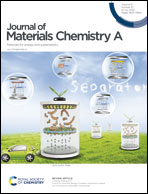CoFe Prussian blue analogues on 3D porous N-doped carbon nanosheets boost the intercalation kinetics for a high-performance quasi-solid-state hybrid capacitor†
Abstract
Prussian blue analogues (PBAs), especially those with crystal water networks, have attracted extensive attention for aqueous electrolyte-based energy storage devices. Herein, we report CoFe Prussian blue analogue (CoFe PBA) nanoparticles grown on interconnected porous nitrogen-doped carbon (IPNC) as an electrode material for a high-performance hybrid capacitor. The CoFe PBA/IPNC hybrid exhibits a high specific capacity of 93.1 mA h g−1 at a current density of 0.5 A g−1 with excellent cycling stability (retention of 91.5%) in 0.5 M Na2SO4 electrolyte. The hierarchical porous carbon support provides sufficient ion diffusion channels, and the numerous electroactive interfaces between CoFe PBA and IPNC enhance reaction kinetics for intercalation charge storage. Theoretical calculations verify the significant influence of the interface interaction between CoFe PBA and IPNC for enhanced electrochemical kinetics. A quasi-solid-state hybrid capacitor assembled using CoFe PBA/IPNC, IPNC, and Na2SO4–PAM gel as the positive electrode, negative electrode, and electrolyte shows high energy density up to 42.9 W h kg−1 and power density up to 14.6 kW kg−1. The flexible device successfully operates an LED paper-watch, demonstrating the potential for practical application.



 Please wait while we load your content...
Please wait while we load your content...